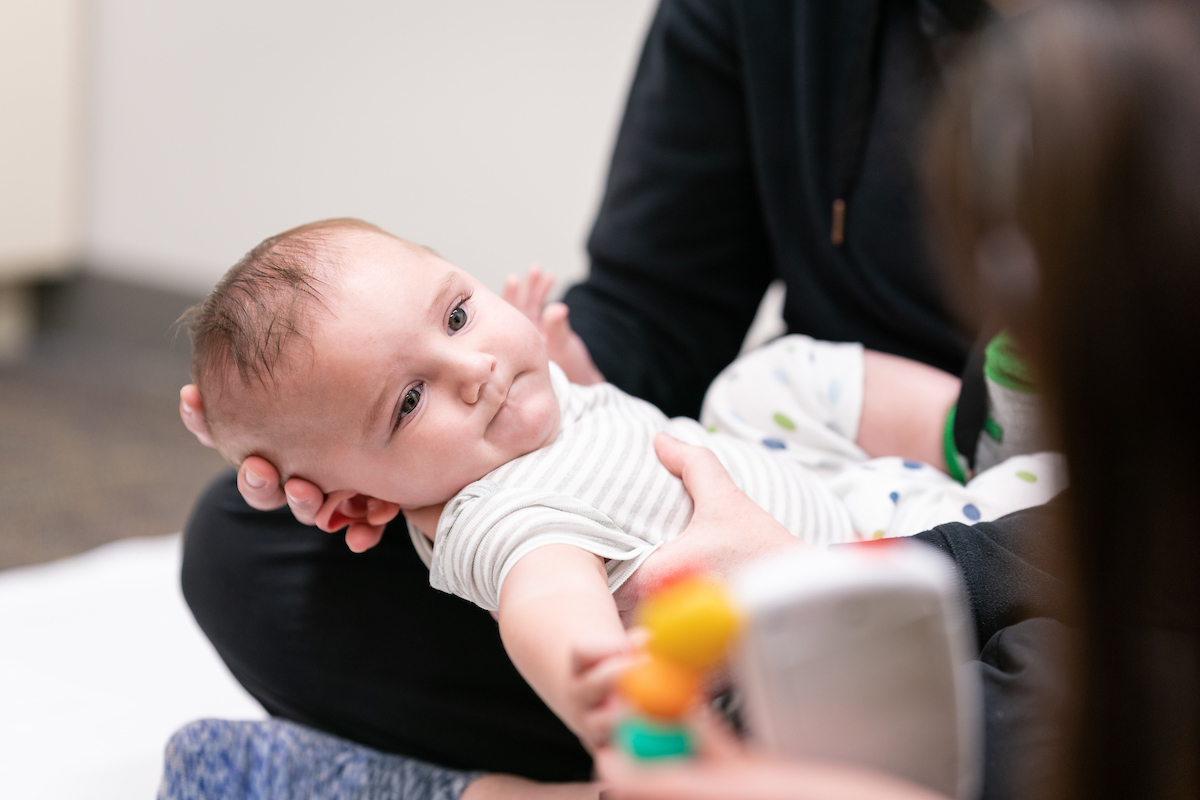
While common and treatable, many parents and caregivers are overwhelmed by the word “torticollis”. What is torticollis? It is a diagnosis where a muscle on the side of a baby’s neck is shortened or tightened. As a result, their head may tilt one way and/or give them limited ability to turn their head to one shoulder.
Determining what causes torticollis depends on a variety of factors. From their position in utero to trauma to the neck muscle during birth, it is hard to pinpoint. However, early diagnosis and treatment is crucial.
Because babies with torticollis experience muscle tightness, more than half of them have a flat spot on the affected side of the head. This is known as deformational plagiocephaly and it is caused by lying consistently in one position. In order to help prevent deformational plagiocephaly, limit a baby’s time in a bouncy chair or car seat, as it encourages them to lay primarily on one side of their head.
If you notice an uneven or irregular head shape, the good news is that plagiocephaly is easily treated. Gillette invented the now world-famous “CranioCap”. It is essentially a helmet that helps re-shape a baby’s head.
Some babies also experience developmental dysplasia of the hip (DDH), also known as brachial plexus injury. DDH, brachial plexus injury and torticollis can all develop due to the baby’s position in the uterus or because of birth trauma.
The good news is that torticollis usually becomes noticeable at birth or shortly thereafter. This means treatment can get started right away.

Early Diagnosis Can Lead To Proper Treatment
If you notice neck tightness, a head tilt or see that your baby has a preference to turn their head one way, it is important to schedule an evaluation with one of the care team experts at Gillette. Our craniofacial team can provide a full examination and help a child get started with a proper treatment plan.
The best way to treat torticollis is with physical therapy. Regular exercises help babies move the affected side of their neck, balancing them out. Tummy time is a great place to start. This helps strengthen your child’s neck and upper body muscles. It encourages them to roll and reach.
It’s also a good idea to use brightly colored toys to get your baby’s attention. Even seeing themselves in a mirror will make them want to turn their head. Some parents or caregivers get their other children involved. Having their brother or sister moving around, talking to them is enough to keep them entertained and engaged.
While every case is unique, torticollis can improve within a few weeks or months of consistent therapy. It is also important to do daily exercises at home, as well.
Physical Therapy Helps Shyla’s Son, Isaiah, Gain Strength
Shyla Hanson has personal experience dealing with torticollis. Her son, Isaiah, was diagnosed at just four months old. With a nephew who had also been diagnosed as an infant, her initial reaction was not one of panic. Being that she was somewhat familiar with the condition, she was relieved that her sister could be a resource. It turns out, torticollis is more common than one might think.
After meeting with the team at Gillette, a proper treatment plan was put into place for Isaiah. He currently is attending physical therapy in the clinic every two weeks, with an at-home regimen three times a day.
“Isaiah is doing very well! Since we’ve been diligent in doing the exercises at home, he is making good progress. I’m feeling relieved and optimistic. I’m grateful for the care and guidance we’ve received thus far,” she said.
As a parent or caregiver, it’s important to know that what works well for Isaiah may not work well for your child. While physical therapy is extremely beneficial for torticollis in general, each physical therapy regimen is specific to the needs of the child. Meet with the experienced rehabilitation team at Gillette Children’s to find out how we can help.

Meet a care team provider, find a location, learn how to get a second opinion, and more.
Request an appointment to connect with Gillette providers.
Do these symptoms sound familiar? Our 30-minute consult appointment could help get answers.
